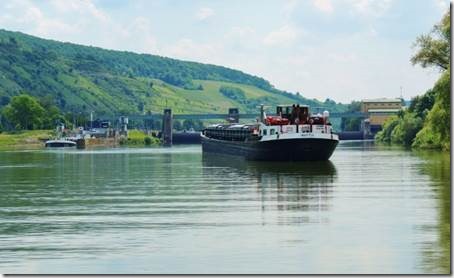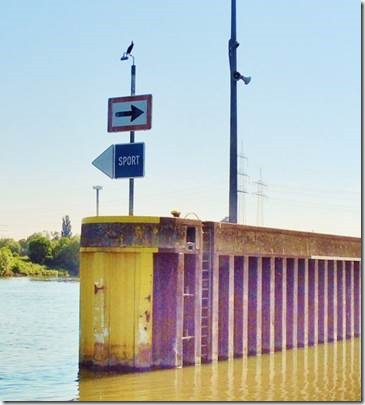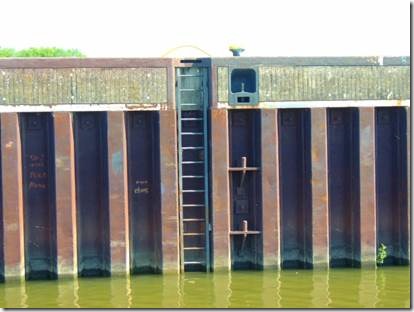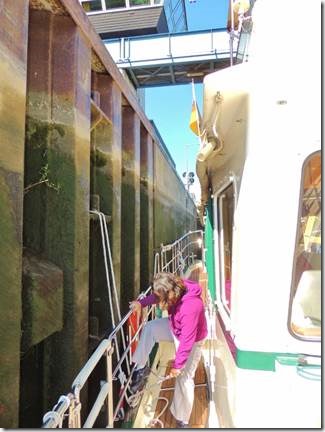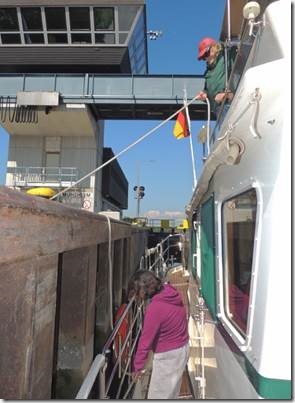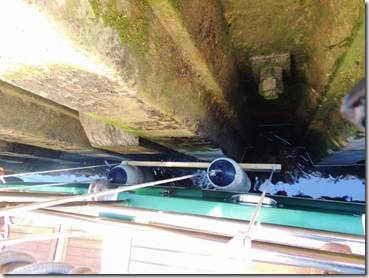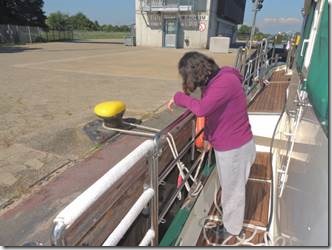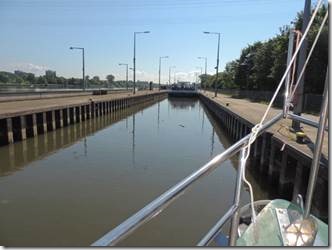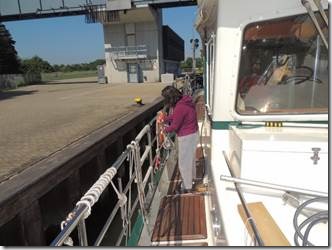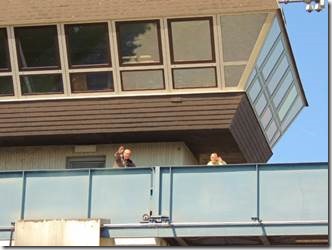Public Dock where the under age kids come to drink and party.
Schweinfurt, Germany
Guten Abend,
Today was a record lock day. We did the most we’ve ever done, 8 ! The first few are fine but by the end you’re really tired of them. We ultimately have to climb 1320 feet and are now 683 feet since we started in Vlissingen, Netherlands. We left Eibelstadt at 7:10 and arrived at Schweinfurt at 5:20 pm having done 60 kilometers average about 10.5 kilometers per hour so the rest of the time was taken by locking.
Today, Schleuse Gerlachshausen, was one of our tallest locks where we rose 6.3 meters. Tomorrow our first lock will be 7.6 meters. 1 meter = 3.28 feet. So that will be almost 25 feet. It’s amazing to go into the lock and see nothing but walls but then at the top there’s a whole world out there.
Ru
Going Upstream (Which is the direction we are going.)
“As the ship approaches the lock, a gate opens up. The ship enters
the lock chamber until the ship is completely inside. The gate behind
the ship closes. Then the lock is filled until it reaches the same water
level as the higher side of the chamber. The second gate opens
and the ship exits at the higher level of the lock.
Going Downstream
As the ship approaches the lock, a gate opens up. The ship enters
the lock chamber until the ship is completely inside. The gate behind
the ship closes. Then the lock is drained until it reaches the same
water level as the lower side of the chamber. The second gate opens
and the ship exits at the lower level of the lock.
http://www.globaljourneys.com.au/
Some locks have chains that are lowered behind the last boat in case the boat should get loose and back up into the lock doors and destroy them. The chains would prevent that from happening.
|
Waiting for the green light to enter the lock. The smaller barge on the left has just left the lock traveling down river. The big barge on the right is waiting to enter the lock to continue up river. There was enough room for us too so we drove into the lock after the large barge was secured. Commercial traffic has priority over pleasure craft. If we get to the lock first, we must wait for the commercial traffic to enter the lock and then hope there’s still room for us. So far we’ve been mostly lucky with our timing at the locks. One time, when we were told it would be 20 minutes before we could enter the lock, Randal dropped the anchor to keep us in place while we waited. Once inside the lock boats are supposed to be in neutral so as not to churn up the water with their propellars and disturb boats behind them. But sometimes the large boats don’t tie up at all and use their engines to keep them in position. That makes it harder for the small boast like us to stay put even with our line secure and we dance around. Sometimes, before we enter a lock, Mary has to call the lock keeper on the radio to ask permission to make sure they’re aware we’re waiting to enter the lock. Each lock and its procedure is mostly similar but also a bit different. |
|
The blue and white sign points “sport” boats away from the lock for commercial shipping to a small lock. But we’re too big for the “sport” lock so we go in with the big boats. |
|
Depending on how many meters you must rise within the lock, you either catch the lowest or middle cleat and work you way up until you’re tied on to the bollard on the top of the lock. |
|
Mary, who has made this same passage several years ago, is the main rope handler. My job is to hook our line to the lock cleat and then Mary pulls it tight. In this photo we have one more cleat to catch before we catch the bollard on top. |
|
Depending on the location of the yellow bollard on the top of the lock, we catch it one of three ways. Here I have handed Randal the line and he caught the bollard and then handed the line back to Mary to tighten it on our cleat. Or sometime I stand up on the lower rail of DoraMac and lasso the bollard. Sometimes the bollard is too far back and out of reach so we tie up to the yellow ladder hand rail cemented into the lock. You just have to wait until you get to the lock and start to rise up to see what needs to be done. It is possible with a crew of just two, but much easier and safer with four. With Mary and me working together it’s much easier to move the lines from cleat to cleat to bollard. Eventually you rise to the correct level and the gates are opened so you can pull in the line and leave the lock. |
|
Looking down between the boat and the walls of the lock. To protect the boat and keep us from rubbing against the wall of the lock, Randal rigged up this board and fender device. The board is getting beaten up and covered with green much but the hull of the boat stays safe. |
|
When the line around the yellow bollard is just above the dock it means we’ve reached our final height. The lock gates open, we get the green light to move ahead, Mary pulls in the line, and we move out of the lock. |
|
Then the line needs to be recoiled and readied for the next lock. |
|
Cyclists waving hello at the lock |

